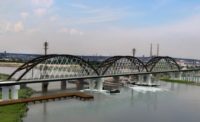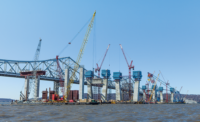State officials in New York displayed for the first time the proposed designs for a new Tappan Zee Bridge across the Hudson River.
The new span will replace an existing bridge about 15 miles north of New York City that joins Westchester and Rockland counties. The officials said the preferred design has the lowest estimated construction cost, shortest estimated construction time and least amount of anticipated dredging.
State officials have not officially identified a preferred bidder, but industry sources and media reports say a team led by Fluor is the leading candidate.
All three of the designs unveiled Dec. 5 by the New York State Thruway Authority and Gov. Andrew Cuomo (D) involve cable-stayed bridges.
Proposal 1, identified as the preferred concept, features two pairs of tapering H-shaped pylons supporting the main span, at an estimated cost of $3.142 billion. It would take five years and about three months to build and require 951,000 cu yd of dredging, according to the presentation.
Proposal 2 features two single pylons, with an estimated cost of $3.99 billion, almost six years of construction and 1.8 million cu yd of dredging. Proposal 3, which would cost $4.059 billion and also take about six years to build, features two pairs of H-shaped pylons and would require 1.55 million cu yd of dredging.
To one experienced bridge designer, the Tappan Zee Bridge concepts all are worthy.
“As cable-stayed construction has become more commonplace for bridges in the span range of the Tappan Zee, it has become more and more difficult for engineers to distinguish their designs,” says John Hillman, senior associate with Teng & Associates, Inc.
A selection committee of artists, architects and engineers has endorsed Proposal 1.
“Each of the proposals submitted for the Tappan Zee demonstrate a tasteful adaptation to try and make a distinction from an aesthetic viewpoint," says Hillman. "But I am not surprised that public sentiment leans towards proposal one. It’s true that beauty is in holding to the simplicity of the cable-stayed form and it’s also not surprising that this simplicity would also lead to the least cost.”
A final decision by state officials on the winning team and proposal is expected by later this month.










Post a comment to this article
Report Abusive Comment